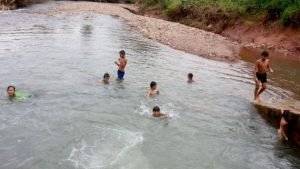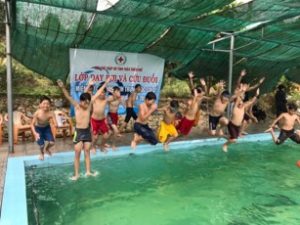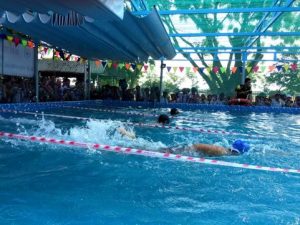On 3 April 2019, the Viet Nam Red Cross Society (VNRC) was awarded ASEAN School Safety Champion for its remarkable work on promoting child safety in Vietnamese schools.
Interventions on school safety framework have been conducted with close engagement with the provincial Department of Education and Training (DoET), school governance, principals, children and teachers, who play key in promoting a culture of risk reduction and disaster safety within their schools and also within the broader communities. This type of behavior change intervention requires time to replicate within the wider community, but results can be seen immediately following implementation of project activities. The intervention relies predominantly on creating a strong group of individuals equipped with the appropriate skills and DRR/CCA knowledge. For example, the School Disaster Management Board, which is interested in making their school a safer place, is also interested in the standardization and dissemination of evacuation plans to increase the likelihood that appropriate measures are taken in the event of a disaster.
VNRC has played an important role in coordinating and advocating at different levels, sharing and promoting good practices and sharing lessons learned on community-based DRM, risk reduction and adaption, Early Warning System, and Safer Schools, with the provincial departments, Ministry of Agriculture and Rural Development and Ministry of Education and Training, and through the informal networks of the Disaster Management and Climate Change Working Groups. This coordination will further enable the experience and outcomes of school safety interventions to be replicated locally and nationally.
In December 2016, the Ministry of Education and Training (MoET) started to develop the guidelines on implementation and assessment of school safety. The development process requires a number of consultation meetings/workshops with relevant stakeholders from national to school level. Documentation of good practices, and lesson learned have been documented during implementation of the Safe School Framework by the Vietnam Red Cross to provide a strong evidence base for MoET to help finalize the framework for Vietnam and the guidelines for application.
The following are implementations carried out by VNRC:
Activity 1: Introduction of Safe School for teachers and students
- Many schools have used various forms to introduce school safety. Trieu Do Primary School, in Quang Tri province, invites parents to participate in school safety training. Primary schools in Quang Ngai and Quang Tri have organized the introduction of school training content to the whole school students (including grade 1, 2 and 3) by integrating the content in class time, flag-raising hours or gender mainstreaming in organizing the school-wide communication contest with the theme of natural disaster prevention such as Truong Quang Trong primary school, campus 2, Quang Ngai city.
- Some primary schools in Quang Ngai and Ha Tinh organized activities to introduce DRR/CCA contents before introducing school safety content. This approach is integrated into the activity 1 and 5 which is a flexible form, for example, Truong Quang Trong primary school, campus 2, Quang Ngai city.
Activity 2: Establishment of Natural Disaster Management Board in school
- Based on actual local conditions, it is flexible on how to implement activities to build the capacity of the School Management Board with the number of members and participants. In addition to the principals, assistant principals, officers in charge, guards, teachers, representatives of the parents which is the most common members of School Management Boards of all schools, a number of schools also mobilizes more health workers or accountants, trade union members and local government representatives at commune or ward levels. In schools in Quang Tri province, the School Management Board delegates a member (either vice principal, general teacher or a technical teacher) in charge of school safety implementation. For some schools that have previously participated in other DRR/CCA projects then they only adjust and consolidate the existing School Management Boards.
- The relationship between the Management Board at the school and the commune/ward Steering Committee for Natural Disaster Prevention and Control was formed through the mechanism of school principal and also member of the commune/ward Steering Committee for Natural Disaster Prevention and Control. This mechanism helps strengthen the linkage of school safety activities with the annual disaster prevention plan of the locality.
- A good practice is the establishment of core group of students to implement school safety at schools in Quang Tri and Quang Ngai with sizes ranging from 14-15 to 20-25 children depending on the number students at school. For elementary schools, mobilize children of grades 3-5, with secondary schools mobilizing children aged 6-7-8-9 with balanced male-female ratio. To mobilize students to join the core group, schools develop criteria for students to join the core group.
Activity 3: School Safety Assessment
- Some schools in Quang Nam and Quang Tri divided the participants of school safety assessment into three groups of teachers, parents and students. Results from the assessment are shared, synthesized and discussed among groups. This method better mobilizes the participation of parents and students, they gather a lot of information from the community because they are local people, understand the local natural disaster situation as well as risk factors appear in the area around the school.
- After organizing the assessment, some schools develop action plan for school safety to save time; and priority measures, plans are shared to get feedback from participants.
Activity 4: Develop School Safety Action Plan
Nam Ha Primary School in Nam Ha Ward, Ha Tinh City has developed an “Evacuation Process” in which steps and step contents are clearly developed. The “evacuation process” is approved by the school as part of the school safety plan for dissemination to teachers and students. The schools also organize evacuation drills so that teachers and students have the opportunity to practice this process.
Activity 5: Implementation of School Safety Action Plan
School facilities
Some schools in urban areas and coastal plains have implemented good initiatives in mobilizing, combining many resources from the state budget, mobilizing contributions from parents and students in combination with support of the project to implement facilities improvements for the school.
Truong Quang Trong Primary School, Campus 2 in Truong Quang Trong Ward, Quang Ngai City is located in an area prone to flooding during storm or flood season. The need to teach children to swim is essential. In the process of implementing the project, the school was approved by the project for a grant of 380 million VND to build a swimming pool but it is required to have local contribution. The school flexibly mobilized Truong Quang Trong ward local government to sponsor VND 80 million from the ward’s budget to reciprocate the grant from the project. In addition, to maintain swimming pool and mobilize swimming teacher for children as the school does not have this staff, the school developed a socialization plan and was approved by the Quang Ngai City Education and Training Department. Accordingly, the school mobilizes parents to contribute 500 thousand VND each, children will learn swimming 1 time a week during the school year. During the summer holidays, the school is allowed to sell service tickets for those in need of swimming. Many parents agree to participate and the school receives enough funds to hire a teacher to teach swimming to students in the school and to look after the maintenance of the pool.
Education on natural disaster prevention and control
- The schools have applied flexibly and creatively in organizing communication activities, raising students’ awareness about school safety and DRR/CCA such as organizing classroom communication conducted by core students and intergration of DRR/CCA contents into school events for the whole school, organizing competitions in different forms with the theme of DRR/CCA.
- The integration of DRR/CCA contents into the official curriculum is introduced by teachers into various subjects such as civic education, science, geography, language arts, etc. Besides materials provided by the project, many teachers also explore additional materials from other sources to enrich contents.
- The organization of DRR/CCA educational activities is also applied by schools through the use of the flag-saluting hours, extracurricular classes, organizing events such as performances and competitions with various forms, attracting participation of students’ families. Through participating in activities such as “Ringing the Golden Bell”, playing the “Dangerous Land” game, etc., have improved students’ knowledge about natural disasters and preventive measures to ensure safety for themselves.
![]()




